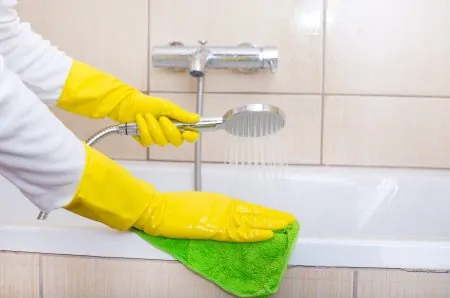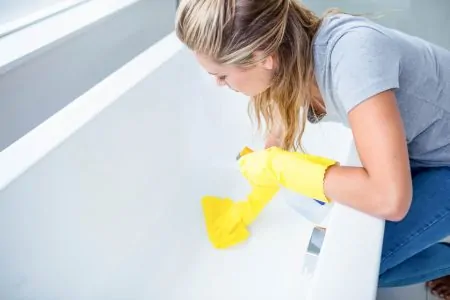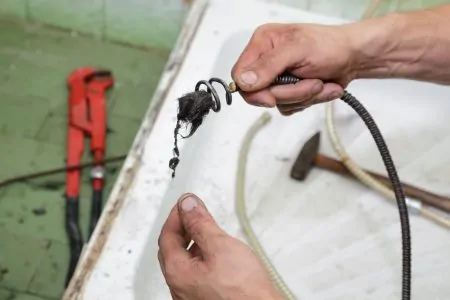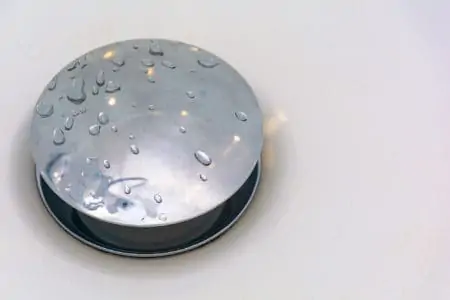Nobody likes bathing or showering in a dirty bathtub, and it can make it more difficult to clean yourself. Cleaning your bathroom ceramics probably isn’t your favorite chore, but it is essential if you want to keep them hygienic.
If your bathtub is stained or discolored, it might appear that its original vibrant finish has been lost. However, there are multiple cleaning methods that can help your tub shine again, including some natural, eco-friendly approaches.
In this article, we will explore how to clean a bathtub using some of the most reliable and straightforward methods. We will then provide some tips on how to keep your bathtub clean so that the next time you wash it will be less daunting.
Key Takeaways
- Use a gentle sponge with a soft and slightly hard side to avoid scratching your bathtub.
- Choose a suitable cleaning product or natural method such as baking soda, vinegar, or lemon juice.
- Regularly clean your bathtub to prevent dirt and grime buildup.
- Avoid using abrasive tools or mixing cleaning products, which can damage the tub or create toxic fumes.
How to Clean a Bathtub
Modern bathtubs have smooth finishes that encourage water to slide off them quickly, reducing the buildup of dirt and grime. Still, they will inevitably get dirty with repeated use. Cleaning them regularly will keep them hygienic and should restore them to their original appearance. Most tubs are manufactured with a shiny or glossy finish, which can be maintained relatively easily with the right products and techniques.
Using a Commercial Product
Cleaning using a commercial product is the most popular way to remove dirt and grime from a bathtub. For this method, we recommend wearing protective gloves because some cleaning products can damage your skin with prolonged exposure.
1. Clear the Tub
Before you apply any cleaning product, clear the tub of debris and remove any hair from the drain. You can also give it a quick wipe with a damp cloth to remove any loose dirt. If you have one, use your showerhead to give the tub a pre-rinse before proceeding.
2. Find a Sponge
When cleaning a bathtub, it is important not to use anything too abrasive. Avoid using steel wool or hard brushes as they can scratch your tub and ruin its finish.
Instead, choose a two-sided sponge with a soft side and a slightly hard side. This will allow you to clean your bath safely, without the risk of causing any damage.
You can also use a small brush — such as a toothbrush or grout brush — to clean around the faucet and drain.
If you have an acrylic bathtub, you might find a Magic Eraser useful. This will conceal scratches, which often appear on acrylic tubs.
3. Find a Suitable Cleaning Product
There is a wide range of bathtub cleaners available today. One of the most popular choices is Lysol Multi-Surface Cleaner. It cuts through grease and grime effectively and leaves your bathroom with a fresh citrus scent.
4. Get Cleaning
Before you start, read the instructions thoroughly. Some products need to be left on the surface for a while to clean it effectively, while others must be applied, scrubbed, and rinsed off quickly.
Important
5. Rinse Thoroughly
Rinsing the bathtub is essential to remove any chemicals so they won’t be transferred to your skin the next time you bathe. Some cleaners will also make the tub’s surface slippery, so be careful when you use it.
Natural Ways to Clean a Bathtub
Getting rid of tough stains and grime isn’t only achievable by using harsh chemicals. In many cases, you can even use household items that are already in your kitchen or utility room.
Using natural methods is also a safer approach in homes with young children. Children are far more sensitive to harsh chemical cleaners, so it is best to avoid using them if you can.
Before You Start
Make sure the tub is completely clear and remove any hair or debris from the drain. Rinse the bathtub thoroughly using the showerhead, then wipe it with a clean cloth to remove any loose dirt.
Method #1: Baking Soda Paste
Baking soda is one of the most versatile natural cleaners. It is highly effective yet safe for most surfaces, including an old stained bathtub.
You can use baking soda to remove bathtub stains, but we use it specifically on rust. Discovering rust on your white tub is very alarming, largely because it can be so difficult to remove.
- Create a paste: Start with 2 tablespoons of baking soda, then slowly add drops of water until it forms a paste.
- Scrub time: Apply the paste to the problem area, then scrub it into the stain.
- Vinegar: If the stains are stubborn, apply some white vinegar to the area after applying the paste. Leave the combination to work its magic for 10 minutes, then scrub it again with a sponge.
- Rinse: Rinse the area thoroughly.
Method #2: Vinegar and Water
Vinegar is a key food ingredient, but it is capable of far more than just flavoring our meals. It is also one of the most effective natural cleaners. Its slight acidity means it works very well against bacteria, mildew, and stains (1).
- Combine: Mix 1 cup of water and 1 cup of vinegar in a spray bottle. Shake it well to mix the solution thoroughly.
- Clean and rinse: Spray the formula onto the problem area, scrub it using a sponge, and then rinse it with clean water.
The strong smell of vinegar might linger in your bathroom for a while, but it will also overwhelm any other odors. If you find the smell too strong or unpleasant, add a tablespoon of lemon juice. Lemon will largely negate the smell of vinegar and make it less pungent.
Method #3: Grapefruit and Salt
Grapefruit is acidic, which makes it excellent at cutting through bacteria and grime (2). Salt is slightly abrasive and will help you get your bathtub clean.
One pleasant side effect of using grapefruit is its citrus scent. If you clean your bathroom using grapefruit, you might not need any other air freshener.
This method is very simple: all you need is a grapefruit and some salt. If your tub is large, you might need two grapefruits to complete the task.
- Prepare the fruit: Cut the grapefruit in half.
- Sprinkle the salt: Cover one-half of the grapefruit with salt and sprinkle a generous amount of salt throughout the bath.
- Scrub: Use the salted grapefruit to scrub the surface, squeezing it gently as you go. As the acidic juice is released, it will begin to work its magic on the stains.
- Switch: When one half of the grapefruit runs out of juice, or there isn’t enough to be effective, switch to the other half. Apply some salt and continue rubbing and squeezing it against the tub.
- Rinse: When the tub has been cleaned, rinse it thoroughly to get rid of any pulp and salt.
Method #4: Lemon and Borax
This is another super-citrus scrub that will get rid of grime. Borax, also known as sodium borate, is excellent at removing tough stains and other problems such as mildew or mold (3).
Top Tip
All you need for this method is a lemon and some Borax:
- Apply the Borax: Sprinkle some Borax onto the stains and a small amount onto half of the lemon.
- Scrub and squeeze: Use the lemon to rub the area while squeezing slightly to release the juices. This will form a paste.
- Wait and rinse: Allow the mixture to work for 15 to 30 minutes — then wipe it away and rinse your bathtub.
Method #5: Baking Soda, Castile Soap, and Essential Oils
If you have some organic soap lying around, you already have most of what you will need for this method. It is highly effective at removing soap scum that often accumulates on the sides and bottom of bathtubs. This solution is also ideal for bathroom sinks.
- Mix soda and soap: Mix one cup of baking soda and half a cup of castile soap in a bowl. Add the soap slowly until the solution thickens.
- Add essential oil: Add about four drops of an antibacterial essential oil, such as peppermint, lemongrass, or tea tree (4).
- Scrub: Apply the mixture to a sponge or cloth and scrub the tub.
- Rinse: When you have finished scrubbing, rinse the bathtub thoroughly with water to remove the cleaner.
Keeping Your Bathtub Clean
If you want to avoid having to deep clean, the best way to clean your bathtub is by washing it regularly. As we shower or bathe, dirt, sweat, grease, soap, and shampoo are left in our baths, as well as an occasional bath bomb.
Regular bathtub cleaning doesn’t have to involve scrubbing or even a cleaning product. You can easily keep your tub clean by giving it a quick wipe after cleaning yourself. Rinse the whole bath thoroughly to get rid of any residue.
Do’s and Don’ts
- Do use soft tools: Use a two-sided sponge or a microfiber cloth to clean the tub. If you’re using an effective cleaner, you won’t need to scrub hard to get rid of stains.
- Do follow instructions: When using a commercial cleaning product, always follow the instructions. If you are unhappy with the results, simply repeat the process.
- Don’t use abrasive tools: Abrasive tools such as steel wool and hard-bristled brushes are a no-go. You should also avoid using scouring powders as they will likely damage the surface.
- Don’t mix products: This is critical as you must never mix substances such as ammonia and chlorine bleach. They will create toxic fumes and can even be fatal (5).













